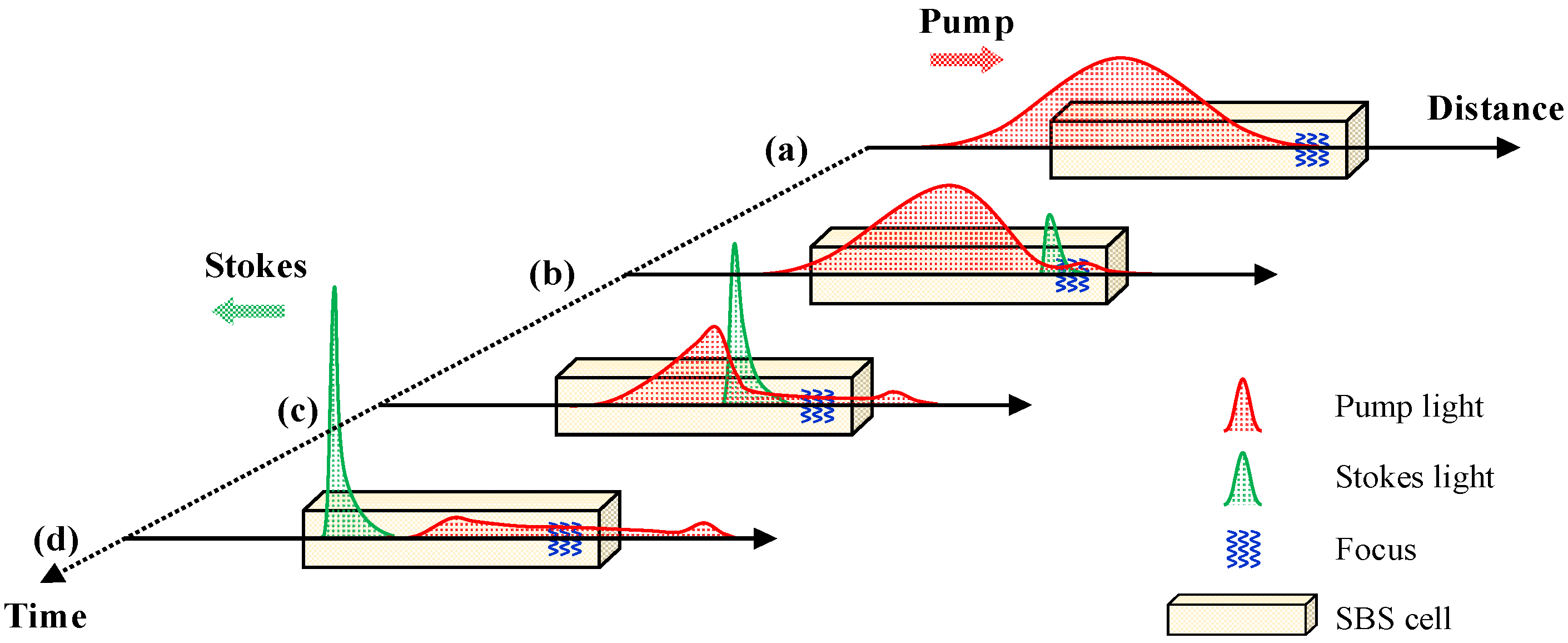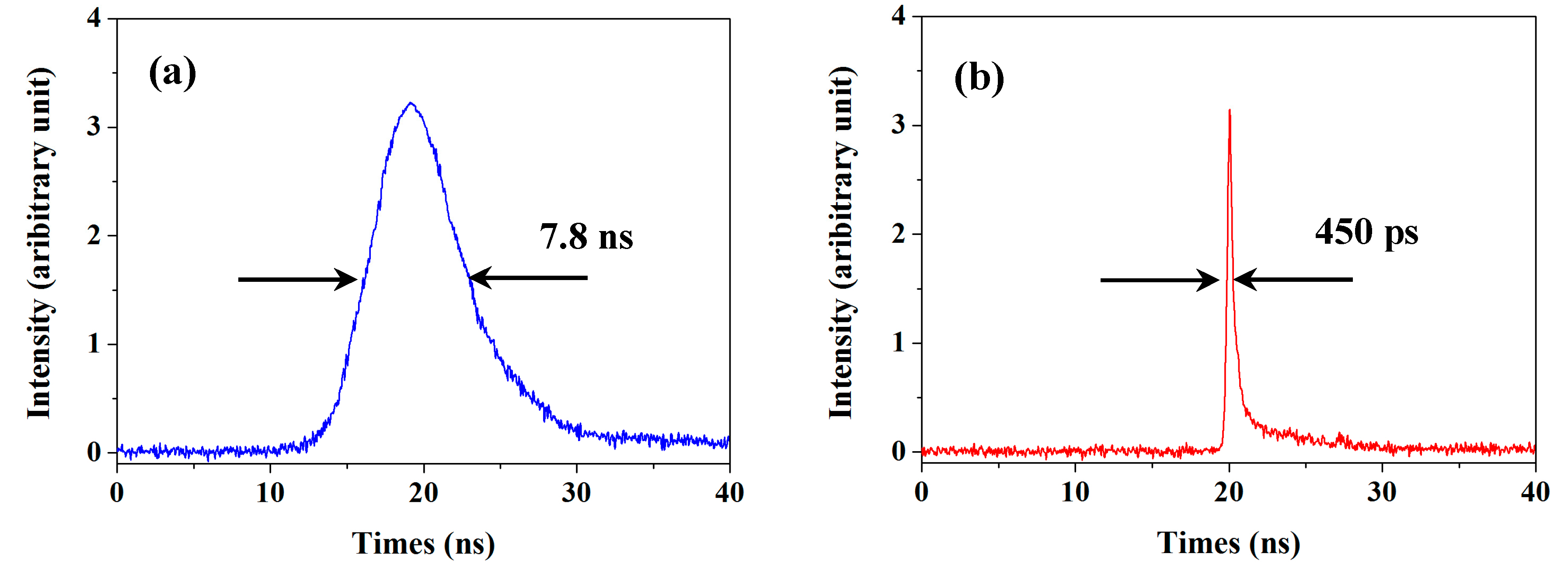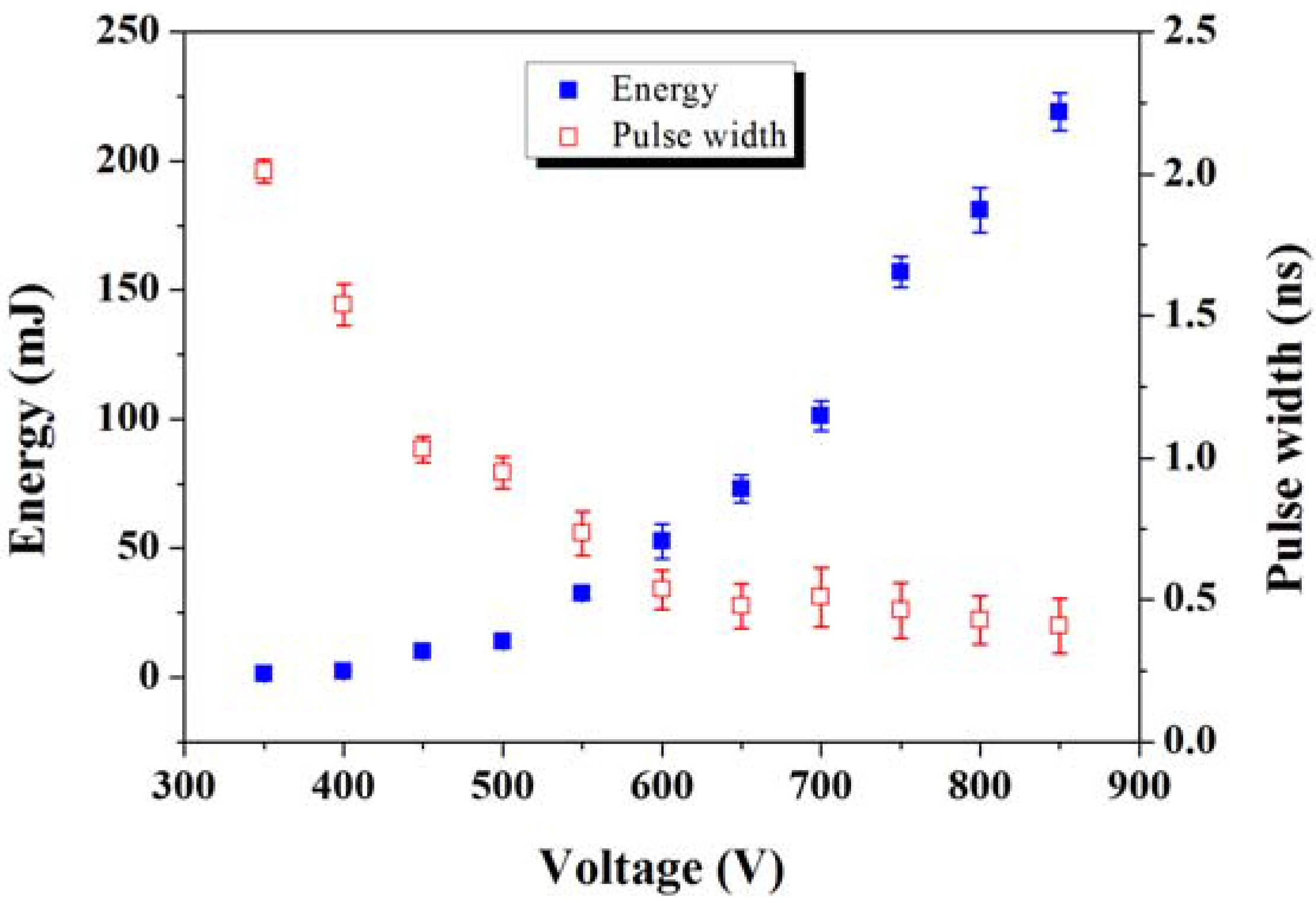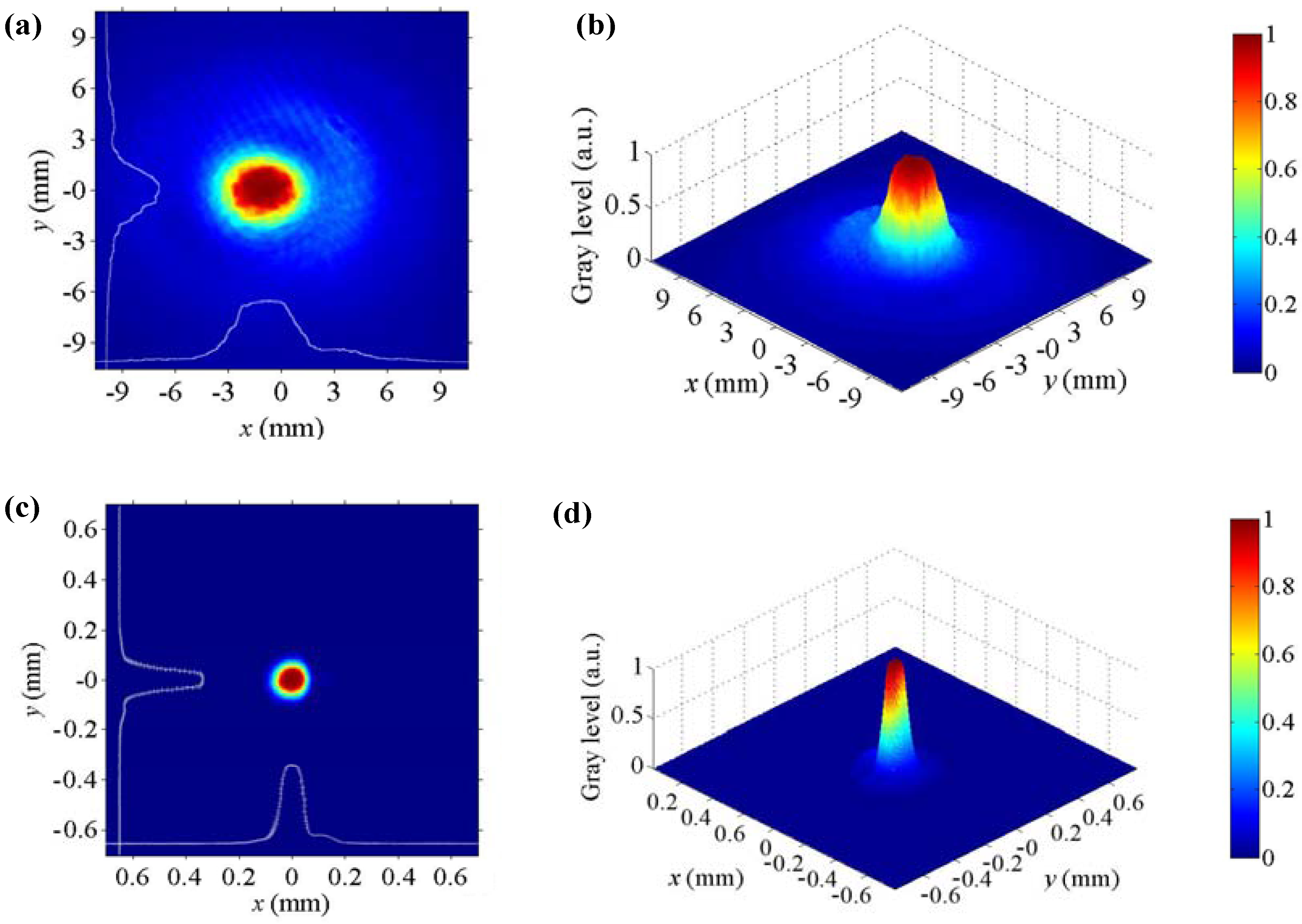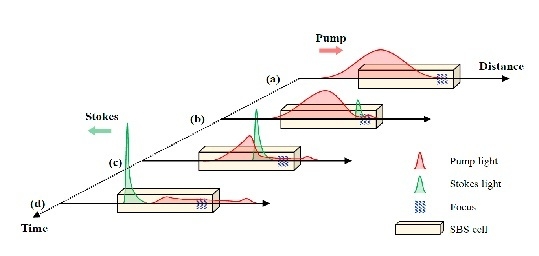1. Introduction
Ultrashort lasers with high energy and high power intensity have wide application prospects, such as laser induced plasma (LIP), space debris detection, laser peening, nonlinear optics, spectroscopy, and laser processing [
1,
2,
3,
4,
5]. Generally, the so-called ultrashort pulse refers to the lasers with pulse width between nanosecond (~ns) and femtosecond (~fs). In terms of output characteristics, the picosecond laser has shorter pulse width and high peak power compared with nanosecond laser; on the other hand, compared with the femtosecond laser, the picosecond laser also has higher stability and easily achieves high energy. These characteristics make picosecond lasers more attractive for many applications.
At present, mode-locking technique is the main method for obtaining picosecond pulses with pulse energies a few nano-joule and repetition rate up to hundreds MHz [
6,
7,
8]. It is necessary to achieve significant higher pulse energies while keeping the pulse duration amplifiers. In this case, regenerative amplifiers are commonly used to strongly amplify selected individual optical pulses from a mode-locked train emitted by oscillators and allow multi-pass through the gain medium placed in an optical resonator. Although the amplification gain is about 10
5 or 10
6 of the injected energy, the maximum energy obtained after the regenerative amplifier is just in the order of few milli-joules as reported [
9,
10,
11,
12]. In addition, the structure of the regenerative amplifier is very complicated with poor stability. Such a low single pulse energy is still unable to meet the needs of a lot of applications. Moreover, in some specific areas, ultra-short pulse lasers with single longitudinal mode (SLM) are often required such as optical sensing, laser radar and optical frequency standard. That means that the mode-locked picosecond laser cannot meet the application requirements in those fields.
The stimulated Brillouin scattering (SBS) phenomenon was discovered decades ago and has been widely used in phase stabilization, pulse compression, beam combination and ultrafast pulse shaping [
13]. Among them, in the field of laser pulse compression, SBS is an effective method to compress a long pulse for its high energy reflectivity and high compression ratio. In particular, SLM output can be obtained by SBS pulse compression due to the Stokes spectrum is the result of convolution of the pump spectrum and the SBS medium gain spectrum. The temporal schematic diagram of SBS pulse compression process is shown in
Figure 1. The medium of SBS cell can be liquid, gas or solid. By SBS pulse compression, Stokes light with pulse width of few and sub- nanoseconds can be obtained [
14,
15,
16]. In order to achieve pulse compression, different types of SBS compressor were designed including taped waveguide, one-cell geometry, oscillator amplifier, compact two cell, scalable two cell, and so on. Three kinds of the most widely used structures are schematically depicted in
Figure 2.
Figure 2a shows the original single-cell pulse compressor with long focal-length lens. This structure suffers disadvantages of easily occuring optical breakdown and low compression ratio that make it unsuitable for practical application [
17,
18].
Figure 2b is the basic two-cell structure with two separate cells: one relatively short cell as a generator, and the other as an amplifier. A short focal lens is adopted to obtain higher reflectivity with less sensitivity to injected energy. In order to ensure the amplification effect, length of the SBS cell in
Figure 2a,b should be no less than shortest theoretical length
L:
where
τ is the pump pulse duration at full width at half maximum (FWHM),
c is the light speed,
n is the refractive index of SBS medium.
Figure 2c is the compact single-cell structure involving a concave mirror coated for high reflectivity at pump wavelength that redirects the generated Stokes light through the same cell for amplification. In this structure, the standing-wave field formed by the forward transmission pump light and backward transmission Stokes light can enhance the stability of SBS generation, then improve the stability of the pulse compression; meanwhile, can also effectively compress the cell length [
19,
20,
21].
Figure 1.
Temporal schematic diagram of simulated Brillouin scattering (SBS) pulse compression process (a) pump light incident to the SBS Cell; (b) backward Stokes light produced near the focus; (c) pump light energy transfer to the leading edge of the Stokes light; (d) compressed Stokes light obtained with a sharp rising edge.
Figure 1.
Temporal schematic diagram of simulated Brillouin scattering (SBS) pulse compression process (a) pump light incident to the SBS Cell; (b) backward Stokes light produced near the focus; (c) pump light energy transfer to the leading edge of the Stokes light; (d) compressed Stokes light obtained with a sharp rising edge.
Although many studies on SBS pulse compression technology have been carried out, most people have just paid attention to the pulse compression ratio. Moreover, most of the light sources used in their previous studies are commercial lasers, and there is no combination of the laser amplifier. To the best of our knowledge, little research on the beam quality, stability and applicability of the SBS pulse compression laser has been carried out.
Figure 2.
Three kinds of pulse compression device based on SBS technology (a) single-cell structure; (b) two-cell structure; (c) compact single-cell structure. Beam splitter: polarizing plate or polarizing prism; λ/4: quarter wave plate.
Figure 2.
Three kinds of pulse compression device based on SBS technology (a) single-cell structure; (b) two-cell structure; (c) compact single-cell structure. Beam splitter: polarizing plate or polarizing prism; λ/4: quarter wave plate.
In this paper, we present a compact high beam quality hundred picoseconds laser system based on SBS pulse compression and aberration compensation techniques. Three-plan resonant reflector method is used to generate SLM Q-switched output combined with Cr4+:Y3Al5O12 (Cr4+:YAG) crystal as saturable absorber. Double-pass amplifier is equipped with a compact single-cell SBS pulse compressor in our design. Multi-constituent medium FC-770 is used in the compressor for its high reflectivity and relatively low price. SLM seed pulses of 9 mJ energy with 7.8 ns pulse width are produced from the oscillator. After passing through the SBS pulse compressor, 7.8 ns pulses are then compressed to less than 500 ps by the SBS pulse compressor. The output energy and compressed pulse width as a function of operating voltages are given. Maximum energy 200 mJ is obtained with beam quality factor M2 less than 1.8 and energy fluctuation measured less than 3%.
2. Experimental Section
The experimental setup of the hundred picoseconds laser system based on SBS pulse compression is shown in
Figure 3. The laser system is composed of a SLM oscillator, an optical isolator, a beam expander and a SBS pulse compressor.
Figure 3.
Schematic layout of the hundred picoseconds laser system. SLM: single longitudinal mode; SBS-PCM: Stimulated Brillouin scattering phase conjugation mirror; FR: Faraday rotator; YAG: Y3Al5O12.
Figure 3.
Schematic layout of the hundred picoseconds laser system. SLM: single longitudinal mode; SBS-PCM: Stimulated Brillouin scattering phase conjugation mirror; FR: Faraday rotator; YAG: Y3Al5O12.
Part 1 is the flash-lamp-pumped SLM oscillator based on three-plan resonant reflector. The Nd3+:Y3Al5O12 (Nd:YAG) rod has a length of 120 mm and a diameter of 3 mm with a 1.0% Nd3+ concentration. The oscillator is passively Q-switched by a Cr4+:YAG crystal with initial transmittance 7.5%. Lower transmittance of the saturable absorber can guarantee the Q-switched output with narrower linewidth and pulse width. The laser cavity is a compact plane-plane configuration with cavity length of 480 mm. M1 is a 0° concave high reflectivity (HR) mirror at 1064 nm. M2 is a flat mirror with reflectivity of 50% at 1064 nm as an output coupler (OC). A Fabry–Perot (F-P) etalon E with the thickness of 2 mm is inserted into the cavity to restrict the SLM output through the interaction with the output mirror M2, which is equivalent to a composite etalon. P1 is a Brewster angle polarizer. An aperture diaphragm (AD) is used to filter high-order mode.
Part 2 is the optical isolator, consisting a polarizer P2, a 1/2 wave-plate and a Faraday rotator (FR), used to guarantee the stability of the system by preventing backward Stokes returning to the oscillator.
Part 3 is the beam expander system with a factor of 2 expands the diameter of the laser beam from oscillator.
Part 4 is the SBS pulse compressor consists of a flash-lamp-pumped Nd:YAG amplifier and a SBS cell. 1.0% doped Nd:YAG crystal with a diameter of 7 mm and a length of 140 mm is used as gain medium. FC-770 is chosen as the SBS medium in the SBS cell, which is a multi-constituent perfluorinated compound with molecular formula of C
7F
15NO. FC-770 has the characteristics of low phonon lifetime (0.57 ns), small Brillouin frequency shift (1081 MHz) and moderate gain coefficient (3.5 cm/GW), which is a suitable medium for SBS pulse compression [
22,
23]. To reduce the optical breakdown caused by impurities, we filter the FC-770 medium in a vacuum using two layers Millipore filter with pore size 0.05 μm. Stimulated Brillouin scattering phase conjugation mirror (SBS-PCM) and pulse compressor are two primary functions of the SBS cell in our experiment. As a PCM, it can compensate the phase distortion caused by thermal effect and inhomogeneity of the gain crystal [
24]. As the illustration of SBS-PCM distortion compensation shows, optical distortion occurred when the seed light (red line) first passes through the laser medium. Due to phase reversal property of the SBS-PCM, after double passing through the optical component, distorted light can be recovered to diffraction-limited (green line) as the original. Meanwhile, the reflected light path from SBS-PCM is strictly same as the incident path, no matter what angle of the SBS cell placed or changed. These remarkable characteristic is helpful for us to realize high beam quality amplified output with high stability. As a pulse compressor, the SBS cell can realize the high efficiency pulse compression of the high energy pulses. The adopted structure of the SBS compressor in our design is a compact single-cell. The length of the SBS cell is 600 mm. To obtain higher reflectance, high compression ratio and sufficient acting length, we insert a convex lens L
3 with focal length 1000 mm in front of the SBS cell. M
5 is a concave total reflection mirror at 1064 nm with focal length 500 mm. After passing through M
5, pump light is focused on the position close to the near incident end of the cell, producing the backward scattering Stokes light. Based on calculation, the beam size at the focus is about 1.6 mm. Through a 1/4 wave-plate, backward Stokes light is reflected from the polarizer P
3 with polarization angle rotated from
p- to
s-polarized.
3. Results and Discussion
The SLM oscillator provides 7.8 ns laser pulses with single pulse energy of 9 mJ at 1064 nm wavelength. The repetition rate of the oscillator is adjustable from 1 to 10 Hz.
Figure 4 shows the SLM seed pulse and compressed Stokes pulse we obtained in our experiment, respectively. The waveform of the oscillator output was given in
Figure 4a showing a rather smooth shape. The diameters of the oscillator output is about 2.3 mm with angle of divergence less than 0.5 mrad. The temporal profile of the output was detected by a photodetector (UPD-40-UVIR-P; ALPHALAS GmbH, Gottingen, Germany) with rising time less than 40 ps, and recorded by an oscilloscope (806Zi-A; Teledyne LeCory Inc., New York, NY, USA) at a bandwidth of 6 GHz. The compressed pulse profile with steep rising edge and pulse width around 450 ps is shown in
Figure 4b.
Figure 5 represents the experimental curve of output energy and compressed pulse width with the change of amplifier voltage, as well as the energy and pulse width stability (error bar). From the curve, we can see that the output energy is near linear growth from 650 to 850 V. One major reason is that with the increase of the injected energy, the SBS reflectivity is obviously improved. The reflectivity we obtained is higher than 75% when the voltage exceeds 650 V. Correspondingly, the output pulse width narrows down rapidly while improving the amplifier voltage from 350 to 650 V. This is because that, at this stage, the leading edge of the Stokes pulse is amplified greatly due to the fast growing gain of the compressor. However, from 700 V to higher voltage, no obvious pulse width compression or changes were observed. The mean reason for the increasing energy contributes little to the compression process is that the Stokes pulse width is close to the FC-770 medium phonon lifetime. The measured root mean square error (RMSE) of output energy at 850 V is less than 3%.
Figure 4.
Temporal pulse profiles of the (a) SLM oscillator seed output; (b) SBS pulse width compressed output.
Figure 4.
Temporal pulse profiles of the (a) SLM oscillator seed output; (b) SBS pulse width compressed output.
Figure 5.
The output energy and pulse width as a function of amplifier voltage.
Figure 5.
The output energy and pulse width as a function of amplifier voltage.
Figure 6 represents the spatial beam characteristics of the output from polarizer P
3 in both near-field and far-field, which were measured by a Charge Coupled Device (CCD) (Camyu Co. Ltd., Chongqing, China). As shown in
Figure 6a,b, the measured beam diameter of near-field is about 6.1 mm in
x-direction and 5.9 mm in
y-direction. The near-field beam divergence angle is less than 0.9 mrad. The 2D and 3D far-field laser intensity distribution profiles are given in
Figure 6c,d, which obtained by a long focal length lens. Both the near-field and far-field show good beam quality.
Figure 7 shows the measured beam radius under output energy of 200 mJ and pulse width around 450 ps at various distances from the lens with
f = 150 mm. The transverse output beam profile was measured by using a 90/10 knife-edge technique. The result indicates a beam quality of
,
in both directions perpendicular to the axis of propagation.
Figure 6.
Intensity distribution of SBS pulse width compressed output (a) 2D distribution of near-field; (b) 3D distribution of near-field; (c) 2D distribution of far-field; (d) 3D distribution of far-field.
Figure 6.
Intensity distribution of SBS pulse width compressed output (a) 2D distribution of near-field; (b) 3D distribution of near-field; (c) 2D distribution of far-field; (d) 3D distribution of far-field.
Figure 7.
Measured beam characteristics of M2 with and .
Figure 7.
Measured beam characteristics of M2 with and .
